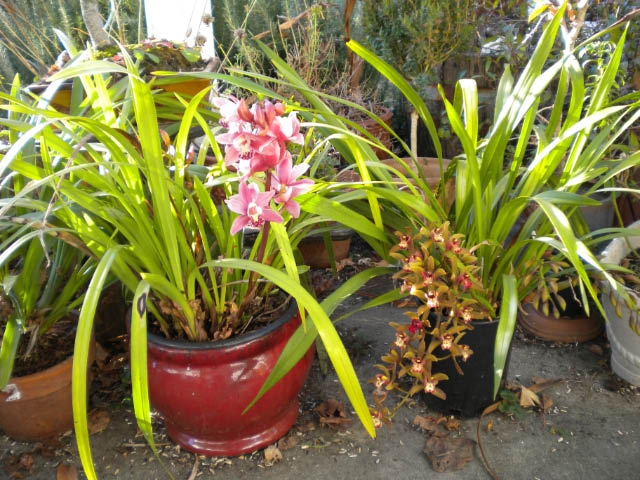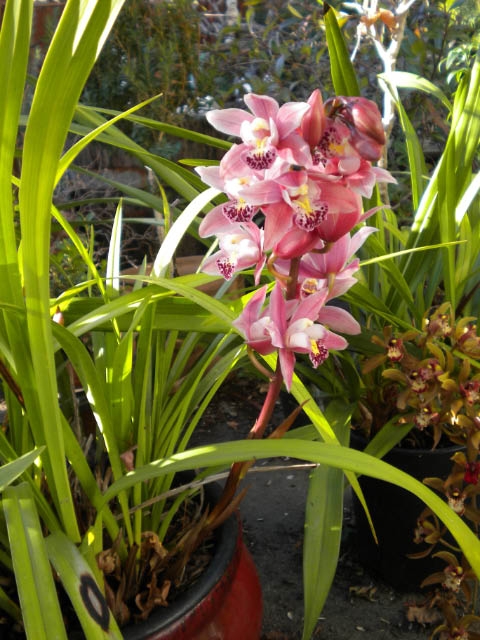UC Blogs
Perspectives on Cymbidiums
I love looking out my sliding glass door to the Cymbidium orchids blooming on my patio. I look forward to bloom time each year. The bloom spikes are amazing, each blossom perfect, intricate, and exotic. I love that the flowers are so long lived whether you leave them on the plant or bring them inside.
It took me a while to find the right place for them. At first, I had them in full sun and they fried during our hot summers. Nest I tried placing them under my Podocarpus gracilus (Fernpine trees) but they got too much shade there, ending up with rich dark green foliage, but no flowers. Finally after we got our lathed patio cover, I put them there and they seem to be doing much better. n They would probably do even better if I would remember to fertilize them on a more regular basis. The books say every 10 -14 days; mine are lucky if they get any once a month.
I'm just impressed that I can leave them outside during the winter. I do cover them with a sheet when frosts are predicted. I also have learned to inspect them frequently for snails and slugs that love to munch on the blossoms. Of course our reactions to plants are often colored by our past experiences. Being a Master Gardener often allows us to talk to gardeners that have come from other places. One couple from Michigan looked ecstatic when they found out they could grow orchids outside, while another gardener from the San Diego area was very disappointed that she would only be able to grow one kind of orchid outside.
The Pollinator Punch at the International Level
It's off to Japan to talk about bumble bees and other pollinators. Pollination ecologist Neal Williams, assistant professor of entomology at UC...
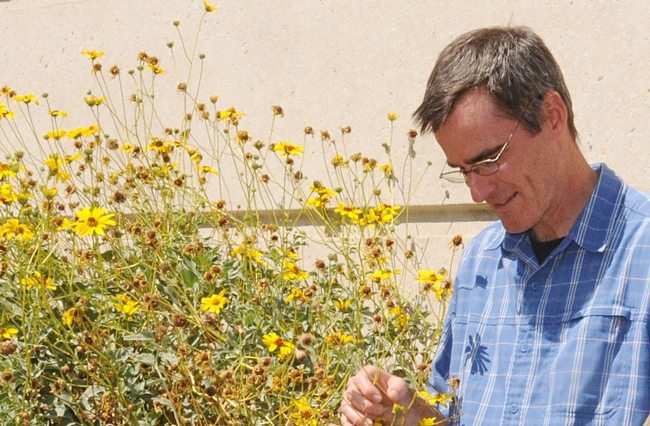
UC Davis pollination ecologist Neal Williams is one of the featured speakers at an international symposium. (Photo by Kathy Keatley Garvey)
Techy Gardening Sites
I love technology. It’s amazing what you can learn! I thought I’d give you a review of a couple of websites I’ve been perusing during the “indoor” months. I’m sure there are hundreds out there but it’s easy to get caught up playing with the tools on one site and hardly ever move on to another, but there is just SO much out there. I tried to include a couple “big” companies and a couple smaller local ones. It should be noted though, just because I review it doesn’t mean the UC Master Gardeners endorse or support the business in anyway.
Many seed companies have sites. Burpee (http://www.burpee.com) is one I enjoy because of the sheer variety of plants available and the information. You can see the most up-to-date hybrids and beautiful photos of ripe, mouth-watering veggies. You can type in your zip code for your planting zone and a planting calendar. You can also view their entire catalog online.
Annie’s Annuals (http://www.anniesannuals.com) is always a favorite with her unusual plant varieties and great descriptions given in a fun and familiar way. You can even make a wish list for those you want to purchase or just put in your imaginary perfect garden. She has an email sign up, as do all the rest, and she’ll keep you informed of new varieties and any specials she might have. The artwork itself is enough reason to visit her site.
Home Depot actually has a pretty nice Garden Club. Whether or not you choose to support the “big orange box” or not, they do have a couple nifty features and will send you coupons to your email (as will all the others). They have the plant identifier, while I found it a bit limited, it is great for the home gardener or when one of us “master’s” just can’t remember. They also have a feature where you can save your “plant tags”, like the ones that come in your six-packs of annuals, in your own file. Even if you have some plants in your yard that are growing from previous years, you can still look up the plant and enter it your file. They also have a nifty place where you can store your own photo album, or publish a picture for all in the “garden club” to see, or ask a question such as “what in the world is this plant?”.
Territorial Seed Company (http://www.territorialseed.com/), has their full catalog available online in pdf version. That is short for Portable Document Format, although I think it to mean Pretty Darn Fast when you compare it to regular mail. So it does give you something to peruse while your waiting for your hard copy (that’s computer speak for the old paper and print version;)
They also have a few videos about planting. They also have an Garden Planner, you’re supposed to be able to plot your garden and track it and arrange it and so on, but at $25, even thought they promise a 30-day free trial, my pocketbook found a buck-fifty and a good ol’ piece of paper the best way to plan for now.
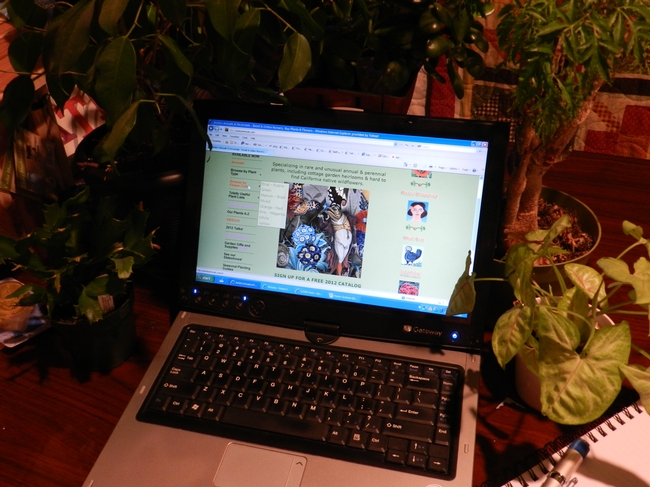
Screen shot of Annie's Annuals site. (photo by Patricia Brantley)
Alfalfa is ice cream in the making
When Khaled Bali looks at ice cream he thinks about alfalfa, wrote Alejandro Davila in the Imperial Valley Press. The story highlighted the research contributions of UC's Desert Research and Extension Center, which this year is celebrating its centennial.
The director of UC Cooperative Extension in Imperial County and an irrigation farm advisor, Bali said that for some people the connection between ice cream and alfalfa is not quite clear. Since alfalfa feeds dairy cattle, it is an important "ingredient" of ice cream.
“Alfalfa is grown here 365 days a year,” said Bali, and uses most of the irrigation water in the Valley and the state.
The article also mentioned entomology farm advisor Eric Natwick's work on sweet potato whitefly and staff research associate Brent Boutwell's work on registering pesticides as part of the UC EPA's IR-4 program.

Ice cream makes UC advisor think of alfalfa.
Bugs for All, All for Bugs
No matter what insect you're interested in, you can usually find your favorite topic at one of the Northern California Entomology Society...
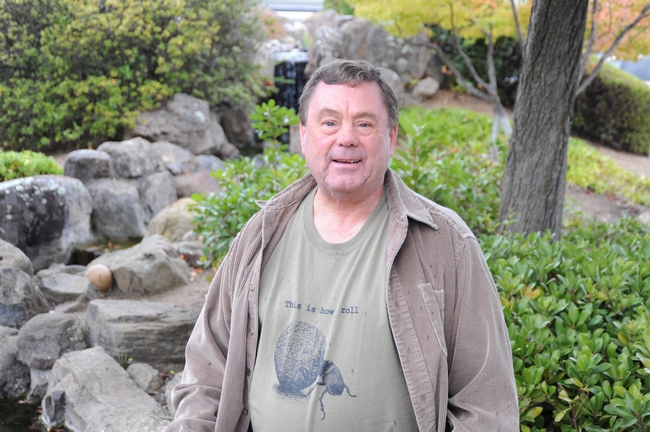
Newly elected president of the Nor-Cal Entomology Society is Robert "Bob"Case of Concord, (Photo by Kathy Keatley Garvey)


